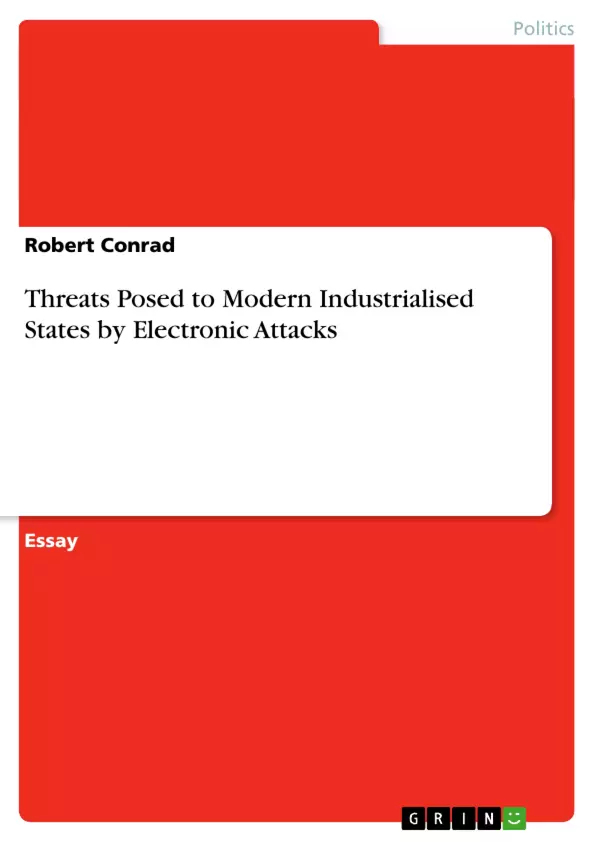One feature of the nation-state is that it has the right to declare war to another na-tion-state (Hughes 1998). Terrorist attacks like that of 11 September 2001 on the World Trade Center (WTC) and the reaction of the USA namely to declare war to the Al Qaeda respectively terrorism, blurs this right, because the terrorists are not a na-tion-state that can be war declared on. The attacks of the terrorists against Western capitalism can also be regarded as a kind of war. Here the war is not declared by a na-tion-state but by a terrorist group. For the reason that International Relations is, among other areas, interested in the processes that concern nation-states, the issue of electronic attacks posed to nation-states is important to be examined.
The main purpose of this essay will be to show that modern states can be threat-ened by electronic attacks. To get into the topic the history of the Internet will be roughly outlined. Then the threats, which can be imposed through this medium, will be basically dealt with as well as the question who launches electronic attacks where, when and why. This essay will also limit its focus concerning the ways in which an electronic attack can be done. Attacks through an electronic network, namely the Internet will be the main focus here. Other devices apart from electronic jamming , HERF Guns , EMP Bombs will only briefly be mentioned.
To be not beyond the scope of this essay the USA will be special attention given to as a deputy for a modern industrial state, because no other country is yet as depend-ent on electronic technology as the USA and therefore vulnerable to electronic at-tacks. But Japan or Europe might be in the future in a similar situation as the USA is today. This paper might therefore be perceived as an early warning, as a mirror or a crystal ball that shows a possible vision of a future scenario of the modern industrial-ised states.
Finally concepts of measures against electronic attacks and a future outlook will round off this text.
[...]
Inhaltsverzeichnis (Table of Contents)
- A Critical Assessment of the Threat Posed to Modern Industrialised States by Electronic Attacks
- The History of Electronic Networks
- Threats Posed by Electronic Attacks
- Information Warfare (IW)
- Electronic Attacks
- Countermeasures and Future Outlook
Zielsetzung und Themenschwerpunkte (Objectives and Key Themes)
This essay aims to demonstrate the potential threat posed to modern states by electronic attacks. It examines the historical development of the Internet and explores the various threats that can be implemented through this medium. The essay specifically focuses on electronic attacks utilizing the Internet as the primary channel, briefly mentioning other forms of electronic attacks.
- The historical development of the Internet and its implications for international relations.
- The various threats posed by electronic attacks, including the use of viruses, worms, Trojan horses, logic bombs, and trap doors.
- The vulnerability of modern industrialized states, exemplified by the United States, to electronic attacks.
- The potential impact of electronic attacks on critical infrastructure, financial systems, and national security.
- The need for countermeasures and strategies to mitigate the threat posed by electronic attacks.
Zusammenfassung der Kapitel (Chapter Summaries)
The first chapter introduces the concept of electronic attacks and their relevance to the study of international relations. It uses the example of the 11 September 2001 attacks to illustrate how terrorist groups can wage a form of war against nation-states without declaring it explicitly. The chapter also outlines the main objectives and scope of the essay.
The second chapter explores the history of electronic networks, tracing their development from the Cold War era to the emergence of the Internet in its modern form. It highlights the importance of the ARPANET as a precursor to the Internet and discusses the impact of the Netscape Navigator on the widespread adoption of the Internet.
The third chapter delves into the various threats posed by electronic attacks. It examines the evolution of computer crime, including the creation of the first computer virus and the spread of viruses through the Internet. The chapter defines information warfare (IW) and describes the various types of software applications that can be used to launch electronic attacks, such as viruses, worms, Trojan horses, logic bombs, and trap doors.
Schlüsselwörter (Keywords)
The main keywords and focus topics of the text are: electronic attacks, information warfare, Internet, national security, vulnerability, countermeasures, computer crime, viruses, worms, Trojan horses, logic bombs, trap doors, modern industrialized states, nation-state, terrorism.
- Citar trabajo
- Robert Conrad (Autor), 2002, Threats Posed to Modern Industrialised States by Electronic Attacks, Múnich, GRIN Verlag, https://www.grin.com/document/8221



